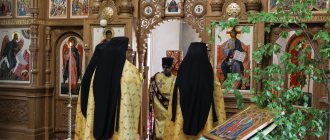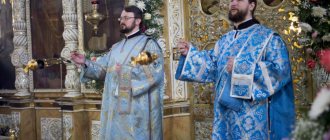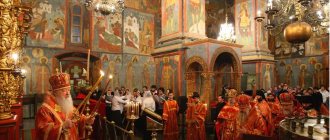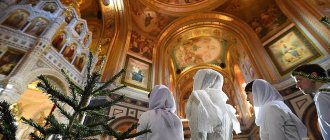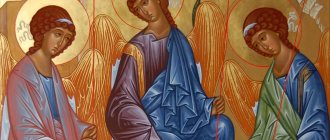I just remember this rule, because it was very often repeated on the occasion of the joint prayer of the Moscow Patriarch with Catholics in the Cathedral of Notre Dame in Paris. If an Orthodox person came to a Catholic church on a tour or just for fun, should he pray there? But it’s a fact - the patriarch prayed in the church. Of course, it is better to do this at a certain time, so as not to disturb those who came to the temple to pray. In Catholicism - hardly. Everyone is sitting on benches there, and walking around the church just to look at it is simply the height of indecency.
Having crossed the threshold of a Catholic church, an Orthodox Christian only needs to slightly bow his head or cross himself according to his custom. Sitting is allowed in Catholic churches. An Orthodox (as well as an unbaptized) person cannot participate in communion. During the service, you should not walk around the temple, talk loudly, or take photographs. Before communion in a Catholic church, it is customary to shake hands with the words “Peace be with you!”, so be prepared to extend your palm as well.
About how Catholics usually behave in church during services and outside of it. Uniform: loose. That's all. Yes that's what! There is one guy who generally crosses himself with “two fingers” like the Old Believers, because he is trying to follow the pre-Nikonian tradition. Turn off the sound on your mobile phone. Regarding liturgical actions: those who are not Catholics are not particularly prescribed anything except decent behavior. You can also show your participation in what is happening by making the sign of the cross at the right moment. At the beginning of the Mass, when the priest says: “In the name of the Father, and of the Son, and of the Holy Spirit,” to which everyone responds “Amen” and makes the sign of the cross.
There may come a time in life when a person of the Orthodox faith will need to go to a Catholic church. Priests can give their blessing only when a believer makes a pilgrimage to common Christian shrines. As in the Orthodox Church, in the Catholic Church there are a number of rules that it is advisable to observe. 7. It is not customary to interrupt prayer in a temple, even if you came with the goal of meeting a specific person. Follow the same rules that apply in any temple. As in the Orthodox Church, smoking and drinking alcohol are not allowed in the church. As mentioned above, it is not advisable for an Orthodox to pray in a church. It is permissible for an Orthodox Christian to attend a Catholic service, although it is not encouraged.
Is it really bad if I, raised in Orthodoxy, go to the Catholic Church? The Orthodox Church is heretical and therefore is against its parishioners visiting others. If you're not truly churched, you probably don't care where you go, so it's hard to explain in the format of these answers. But Catholicism is still not Orthodoxy. And who said that God is in an Orthodox church or a Catholic church, in a Lutheran church or a Protestant prayer house, in a Buddhist pagoda or a Vaishnava ashram??
How to behave correctly in an Orthodox church
As a rule, Orthodox churches have three entrances: the main (western, opposite the altar), northern and southern. The entire church building is divided into the altar, the temple itself and the vestibule. The altar is separated from the temple itself by an iconostasis, which in most cases reaches the ceiling. The altar contains the throne and the altar. The Royal Doors (central), as well as the northern and southern doors lead to the altar.
Women are prohibited from entering the altar. Men can enter the altar only with the permission of the priests, and then only through the northern or southern doors. Only clergy enter the altar through the Royal Doors.
Directly adjacent to the iconostasis is the solea - an elevated platform along the entire altar. Opposite the royal doors is the ambo - the central part of the solea. Without the permission of the clergy, it is also not allowed to ascend to the pulpit and solea.
Since ancient times, it has been established to perform divine services three times a day: in the evening, in the morning and in the afternoon - the liturgy. You should know that the church day begins not at 0 o'clock on the calendar day, but at 18 o'clock on the previous day.
The entrance to the temple from the street is usually arranged in the form of a porch - a platform in front of the entrance doors, to which several steps lead. When approaching the temple, you need to make the sign of the cross and bow from the waist. When going up to the porch, before entering the doors, you again need to sign yourself with the sign of the cross. You should not pray for a long time and for show while standing on the street.
You should arrive at the temple 10-15 minutes before the start of the service. During this time, you can submit notes, put a donation on the eve, buy candles, put them on and venerate the icons. If you are late, you must behave in such a way as not to disturb the prayer of others. If it is not possible to freely approach the icons and light candles, ask them to pass the candles through other people.
During the service, men should stand on the right side of the temple, women on the left, leaving a clear passage from the main doors to the Royal Doors. It is forbidden to sit in an Orthodox church, the only exception being the parishioner’s ill health or severe fatigue.
In a temple, it is indecent to show curiosity and look at others. It is unacceptable to condemn and ridicule the involuntary mistakes of employees or those present in the temple. It is forbidden to talk during the service. One should not condemn or reprimand a newcomer who does not know the church rules. It is better to help him with polite and kind advice. Candles should only be purchased from the temple you came to. If possible, you should not leave the temple until the end of the service.
When visiting temples, you are supposed to dress so that most of your body is covered. It is not customary to go to church in shorts and sportswear. Whenever possible, men and women should also avoid T-shirts and short-sleeved shirts. A woman's head must be covered. Men are required to remove their hats before entering the temple.
In an informal setting, clergy are usually called as follows:
- Patriarcha - His Holiness;
- bishop - lord;
- priest - father;
- abbess - mother;
- deacon - father deacon.
It is not customary at meetings to greet clergy with exclamations: “Hello, father!” or “Hello, master!” You should say: “Father, bless!” or “Master, bless!”
You should not ask for blessings from deacons and ordinary monks, since they do not have the right to do this. Priests and bishops, as well as abbess of monasteries in the rank of abbess, bless. When accepting a blessing, you should fold your palms crosswise (right palm on top of the left) and kiss the right, blessing hand of the clergyman; there is no need to cross yourself before doing this.
Exit from the temple
Here Catholics always approach a vessel with holy water, dip their fingers into it and cross themselves - this is a symbol of received baptism as such. So don’t stay late unless you plan to do so so as not to disturb anyone! Even to photograph the cathedral on the way out, you will simply disturb people.
And a Catholic monastery in the USA, by the way, demands in the meantime to introduce a road sign “Caution, nun!” And this is even common sense. In fact, it would be worthwhile for some ill-mannered tourists to hang “Beware of religion!” signs on cathedrals. Because otherwise the desecration of the temple begins simply out of stupidity and ignorance...
Rules of conduct in a Catholic church
A Catholic church has generally the same structure as an Orthodox church. The most significant difference that catches your eye is the absence of an iconostasis. Instead, there is a low altar barrier. The temple has a central part - the altar, or presbytery - the place where worship takes place and where the Holy Gifts - bread and wine transubstantiated into the Body and Blood of Christ - are kept. You can recognize this place by the unquenchable lamp burning in front of the tabernacle.
In addition to the central altar, there may be side chapels in honor of saints. The church also has a special place for the choir and a sacristy (a separate room for church servants and storage of liturgical vestments and objects).
Men must remove their hats when entering the temple. Headscarves are not required for women. There are also no special standards in clothing or use of cosmetics. Appearing in the temple in shorts or too revealing clothing is not welcome, and in some temples, including St. Peter's Basilica in the Vatican, it is prohibited.
At the entrance to the temple there is a vessel with consecrated water, or a crypt, into which the fingers of the right hand are dipped and then crossed.
Immediately upon entering the temple, kneeling (right knee) is performed before the tabernacle. And subsequently, passing by the tabernacle, they kneel or at least bow their heads. Catholics are baptized in a different order from Orthodox Christians - first the left shoulder, then the right. There are no special moments outside the liturgy when the sign of the cross is required.
In the temple there are rows of prayer benches, and at the bottom there are low benches (people kneel on them during worship). Confession in a Catholic church is performed in special confessionals - small booths for the priest and the confessor. If someone is talking in the confessional, you should not be within earshot, nor should you approach the priest during his conversation with someone - this can be a purely spiritual and personal conversation. One should not interrupt the prayer or silent contemplation of believers; one should wait until they finish.
Actually, this limits the basic rules of conduct in a Catholic church.
The head of the Catholic Church is the Pope.
Appeals to clergy:
- to the Pope - Your Holiness;
- to the cardinal and archbishop - Your Eminence;
- to the bishop - Your Eminence (personal - Vladyka).
For persons belonging to the highest church hierarchy, the title “Monsignor” is also used, added to the title. The rector of the temple is addressed as “Your Reverence.” In a personal conversation, you can address all priests as “father,” monks as “brother,” and nuns as “sister.”
It is very difficult to distinguish one rank from another in everyday life, therefore, when preparing for a meeting with a priest, you need to know his title in advance. However, the presence of a red belt, piuska (a red bishop's cap or a non-black cassock), as a rule, indicates belonging to the highest hierarchy. True, in everyday life the priesthood wears ordinary dark suits with dark shirts and a white stripe under the collar.
In communication with the priesthood, two levels must be distinguished - the one when during a meeting the priest is called to perform a divine service or sacrament, and the usual conversation. The conversation is subject to the rules of normal etiquette.
The Catholic priesthood takes a vow of celibacy, so it is tactless to be interested in the family life of your interlocutor. Another feature is that, as a rule, the priest is the first to offer his hand, including to women.
Who were Orthodox or Catholics before?
1. The split of the Christian Church occurred in 1054. The Church was divided into the Roman Catholic in the West (center in Rome) and the Orthodox in the East (center in Constantinople). ... - Orthodoxy denies the dogma of the Immaculate Conception, Catholicism - on the contrary.
Interesting materials:
Why doesn't my headphone microphone work on my computer? Why does my computer restart on its own? Why does the computer monitor screen blink? Why does the computer screen blink? Why is my computer monitor blinking? Why doesn't the mouse work on the computer? Why does it say no signal on the computer screen? Why do horizontal stripes appear on my computer screen? Why do stripes appear on my computer screen? Why does the computer screen show no signal?
Rules for visiting the synagogue
The center of religious and social life of the Jewish community is the synagogue.
Currently, various currents coexist in Judaism - from ultra-Orthodox to ultra-liberal. Accordingly, synagogue services in different Jewish communities can vary significantly. The ancient traditions are most preserved in Orthodox Judaism.
Services in Orthodox synagogues are usually held three times a day; On holidays and Saturdays, additional prayers are read. For worship to take place, at least ten men over 13 years of age must be present to form a minyan (quorum).
The seats for women in the synagogue are either separated from the seats for men by a partition, or women occupy seats in the gallery.
Men are forbidden to be in the synagogue with their heads uncovered, so during morning prayer they wear a special prayer shawl (tallit), which is a rectangular piece of woolen material with four tassels at the corners (tzitzit). On weekdays, during morning prayer, men put on tefillin - leather boxes with pieces of parchment with passages of Holy Scripture enclosed in them. With the help of long straps, these boxes are tied to the forehead and left hand of the worshipers.
Prayers are said standing or sitting: those praying are not allowed to prostrate or kneel, with the exception of certain moments of festive services.
When entering the synagogue and reading some prayers, it is customary to bow your head. Prayers are recited in Hebrew, and a number of prayers are recited in Aramite (Aramaic), the language of everyday communication of the ancient Jews.
The order of worship developed over the centuries involves the recitation of certain prayers, the sequence of which corresponds to one or another day of the religious calendar. Any adult Jewish male can lead a service. In large communities, a particularly revered person (khazzan) is usually appointed to read prayers on holidays and Saturdays, sometimes accompanied by a male choir. Some parts of the liturgy are sung by everyone present in the synagogue.
In many communities belonging to other branches of Judaism - Conservative, Reform, Liberal - synagogue traditions can differ significantly. Thus, in reform communities, men and women sit together. Men may not wear a tallit or tefillin, although they often wear a special cap (kippah) on their heads. The synagogue choir in Reform and many Conservative synagogues includes women. In many countries, part of the service may be conducted in the language of that country, and the ratio of prayers in Hebrew to prayers in another language varies among different communities. The very composition of prayers in the services of various communities is also changing.
Rabbis still lead Jewish communities today, although much of their leadership is in the nature of spiritual mentoring. The responsibilities of rabbis include organizing solemn religious ceremonies - marriages, funerals, etc.
The functions and position of the rabbinate may differ in different countries of the world. Thus, in Israel, rabbis are government officials. They are confirmed in office by the chief rabbis and the Ministry of Religious Affairs and take on some of the important government and judicial functions.
Unlike other religions, where there are certain rules of etiquette in dealing with clergy of various ranks, in Judaism as a whole there are no such rules. The only thing is that when addressing a rabbi by name, the word “rabbi” is sometimes added.
Advertising


